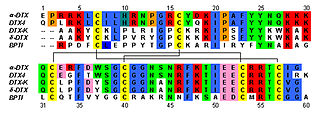
Dendrotoxins are a class of presynaptic neurotoxins produced by mamba snakes (Dendroaspis) that block particular subtypes of voltage-gated potassium channels in neurons, thereby enhancing the release of acetylcholine at neuromuscular junctions. Because of their high potency and selectivity for potassium channels, dendrotoxins have proven to be extremely useful as pharmacological tools for studying the structure and function of these ion channel proteins.

Maurotoxin is a peptide toxin from the venom of the Tunisian chactoid scorpion Scorpio maurus palmatus, from which it was first isolated and from which the chemical gets its name. It acts by blocking several types of voltage-gated potassium channel.

Margatoxin (MgTX) is a peptide that selectively inhibits Kv1.3 voltage-dependent potassium channels. It is found in the venom of Centruroides margaritatus, also known as the Central American Bark Scorpion. Margatoxin was first discovered in 1993. It was purified from scorpion venom and its amino acid sequence was determined.

Cobatoxin is a toxin present in the venom of the scorpion Centruroides noxius. It blocks two potassium channel subtypes; voltage-gated and calcium-activated channels.
Kaliotoxin (KTX) inhibits potassium flux through the Kv1.3 voltage-gated potassium channel and calcium-activated potassium channels by physically blocking the channel-entrance and inducing a conformational change in the K+-selectivity filter of the channel.

Heteroscodratoxin-1 is a neurotoxin produced by the venom glands of Heteroscodra maculata that shifts the activation threshold of voltage-gated potassium channels and the inactivation of Nav1.1 sodium channels to more positive potentials.

Pandinotoxins are toxins from the venom of the emperor scorpion Pandinus imperator. They are selective blockers of voltage-gated potassium channels
Butantoxin (BuTX) is a compound of the venom of three Brazilian and an Argentinean scorpion species of the genus Tityus. Butantoxin reversibly blocks the voltage-gated K+ channels Shaker B and Kv1.2, and the Ca2+-activated K+ channelsKCa 1.1 and KCa 3.1.

Pi3 toxin is a purified peptide derivative of the Pandinus imperator scorpion venom. It is a potent blocker of voltage-gated potassium channel, Kv1.3 and is closely related to another peptide found in the venom, Pi2.
Tamulotoxin is a venomous neurotoxin from the Indian Red Scorpion.
HsTx1 is a toxin from the venom of the scorpion Heterometrus spinifer. HsTx1 is a very potent inhibitor of the rat Kv1.3 voltage-gated potassium channel.
Spinoxin is a 34-residue peptide neurotoxin isolated from the venom of the Malaysian black scorpion Heterometrus spinifer. It is part of the α-KTx6 subfamily and exerts its effects by inhibiting voltage-gated potassium channels, specifically Kv1.2 and Kv1.3.
Pi4 is a short toxin from the scorpion Pandinus imperator that blocks specific potassium channels.

ImKTx88 is a selective inhibitor of the Kv1 ion channel family that can be isolated from the venom of the Isometrus maculatus. This peptide belongs to the α-KTx subfamily and is classified as a pore-blocking toxin.
BmP02, also known as α-KTx 9.1 or Bmkk(6), is a toxin from the Buthus Martensi Karsch (BmK) scorpion. The toxin acts on potassium channels, blocking Kv1.3 and slowing the deactivation of Kv4.2. BmP02 is not toxic to humans or mice.

Wasabi receptor toxin (WaTx) is the active component of the venom of the Australian black rock scorpion Urodacus manicatus. WaTx targets TRPA1, also known as the wasabi receptor or irritant receptor. WaTx is a cell-penetrating toxin that stabilizes the TRPA1 channel open state while reducing its Ca2+-permeability, thereby eliciting pain and pain hypersensitivity without the neurogenic inflammation that typically occurs in other animal toxins.

The Tst26 toxin is a voltage-gated potassium channel blocker present in the venom of Tityus stigmurus, a species of Brazilian scorpion. Tst26 selectively blocks Kv1.2 and Kv1.3 channels.

OdK2 is a toxin found in the venom of the Iranian scorpion Odonthobuthus doriae. It belongs to the α-KTx family, and selectively blocks the voltage-gated potassium channel Kv1.3 (KCNA3).

OSK3, from the venom of the scorpion Orthochirus scrobiculosus, is a potassium channel blocker that belongs to the α-KTx8 subfamily and targets the voltage-gated potassium channels KCNA2 (Kv1.2), and KCNA3 (Kv1.3).
BmKTX is a scorpion neurotoxin which blocks the voltage gated potassium channel Kv1.3.












